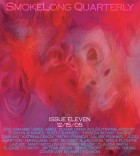Terrific story. Could you (please) explain the process from conception to this wonderful finished product?
I chose the neglected garden because I wanted a setting that would lend itself well to expansion. An image of a man tending to land he hated appeared on the page and I spent the rest of the story trying to figure out what made him so angry, what led him to drink as much as he did. Again, I considered Hemingway. So many of his male characters are these angry, quasi-alcoholic men who were plagued by women they no longer loved and I thought there was potential for that kind of dynamic in Green Monster. When Florine visits him in the garden, you have to wonder what these two had gone through for her to offer him a drink. And if Jones wants to be at the bar, watching the game, why doesn’t he just throw down the hoe and go?
Ambiguity really drove this piece, and rather than seeing that as a problem, I hope it provides space for readers to interpret the actions according to their own subjectivities.
Did Florine hand Jones beer or soda? If beer, is she trying to assuage him with alcohol? If soda, is she passing judgment on his drinking and his flask? Did Jones drink the beverage out of defiance or surrender? Did he leave the grubs in the garden because he wanted the garden to suffer more, or do they (as pupae) symbolize a new beginning? Even as the author, I didn’t know what was at the root of this couple’s animosity, although I concluded that the ambiguity could provide multiple explanations and scenarios.
A really amazing final paragraph. Love the authorial control, the risk-taking with style. Is such risk-taking essential to flash fiction?—and writing in general? And how would you describe your style? How do you go about crafting such wildly inventive and powerful sentences?
I’m not sure that I took risks with this story, save for the fact that I didn’t attempt to explain the backstory of this couple. I had few expectations for its outcome as a “story” and so the usual inhibitive factors that tend to surface when I write never did. In fact, throughout the entire writing process, I felt like I was playing with words and ideas. It was very freeing.
In crafting each sentence, I wrote it first in my own style. Then I evaluated it and asked, how would Hemingway have written this? How can I eliminate superfluous adjectives? How can I make this sentence “travel?” For example, “lacy bean leaves,” resulted in “the lace of bean leaves.” I kept turning a critical eye inward and I think my willingness to edit myself in this way helped me to develop and improve the entire text.
I am still developing my literary style, although I know wordplay and double meanings oftentimes surface. For example, in Green Monster, it occurred to me halfway through that the garden was a metaphor for the Jones’ relationship. Suddenly, all the words held double meaning. The split tomatoes, the wax of pepper, aging lettuce: these seemingly healthy foods, gifts from the earth, over-aged and past prime but still living (somehow) in this ratty garden. The dual meanings and language described not only the garden environment, but also the dynamics of the couple.
The title, Green Monster, illustrates the possibility of multiple interpretations. Red Sox fans (and enemies) know the large wall at Fenway is called Green Monster, but in this story it is also the out-of-control garden, and the jealousy and hatred lurking between Jones and Florine. So the Green Monster becomes mix of desire, life and community, as well as a symbol of hatred and jealousy.
Tell me more about Florine and Jones—all you can!
Something unforgivable happened between Florine and Jones a long time ago and they still haven’t healed from it. Both erred, both still feel guilty and neither really knows how to move beyond it.
Jones is an alcoholic, a Red Sox fan, a smoker. He flirts or maybe fornicates with barmaids and otherwise despises his life. He doesn’t have the ambition or drive to make changes for improvement – perhaps he even enjoys being miserable. He resents his obligation to the garden, and undermines its health by not removing the harmful grubs. Perhaps it is a kind of revenge on his wife.
Florine is not as easily describable because the reader “sees” her through Jones’ point of view. I had hoped the squeak of sneaker on the lawn suggests youthfulness still lingers. I hadn’t expected so much politics to surface over a woman offering a man a cold drink. But I don’t think Florine could have done anything right in the situation.
This was a strange story to write. I hadn’t known what the source of the Jones’ rift was, even after I finished writing it. I literally had to write two more stories about them to figure it out.
How has the creative writing program at East Carolina influenced your writing? How has your writing improved? Any negative aspects of being enrolled in such a program?
The creative writing program at ECU provided me with the forum and structure I needed to segue from newspaper reporting to fiction. There are excellent creative writing and literature professors here that help me to stretch my abilities as a reader and writer. I feel like I can better draw from the world around me and make sense of it through writing fiction.
The downside of the program is that there are not enough creative writing professors and so the faculty takes on more students than they probably should. Also, the degree program offered is for an MA, not an MFA. So I still have some schooling ahead of me should I seek to pursue the MFA.
A new year approaches (yikes!). So, what’s the best that 2005 had to offer in literature, web sites, music, movies, television, DVD, and the like? Also, any predictions for 2006? And we’d love to hear your New Year’s resolution.
Most of the reading that I have done this year has been related to my coursework, but I’m looking forward to reading A Long Way Down by Nick Hornby and Zadie Smith’s On Beauty. For web sites, I used to check in with Drudge and Wonkette daily, but grew tired of their snark. I always visit Killingthebuddha.com when I think maybe I should go back to church. It was really nice of the Grateful Dead to offer free downloads of their music. Watching The Office and King of the Hill are guilty pleasures, but other than that I don’t watch TV.
I resolve, in 2006, to take better care of my garden and my loved ones. And (per recommendation of Eleanor Roosevelt) to scare myself once a day: talking to strangers, running with scissors and anything else that forces me to break from, umm, that beaten path in the yellow wood.



 The core workshop of SmokeLong Fitness is all in writing, so you can take part from anywhere at anytime. We are excited about creating a supportive, consistent and structured environment for flash writers to work on their craft in a community. We are thrilled and proud to say that our workshop participants have won, placed, or been listed in every major flash competition. Community works.
The core workshop of SmokeLong Fitness is all in writing, so you can take part from anywhere at anytime. We are excited about creating a supportive, consistent and structured environment for flash writers to work on their craft in a community. We are thrilled and proud to say that our workshop participants have won, placed, or been listed in every major flash competition. Community works.